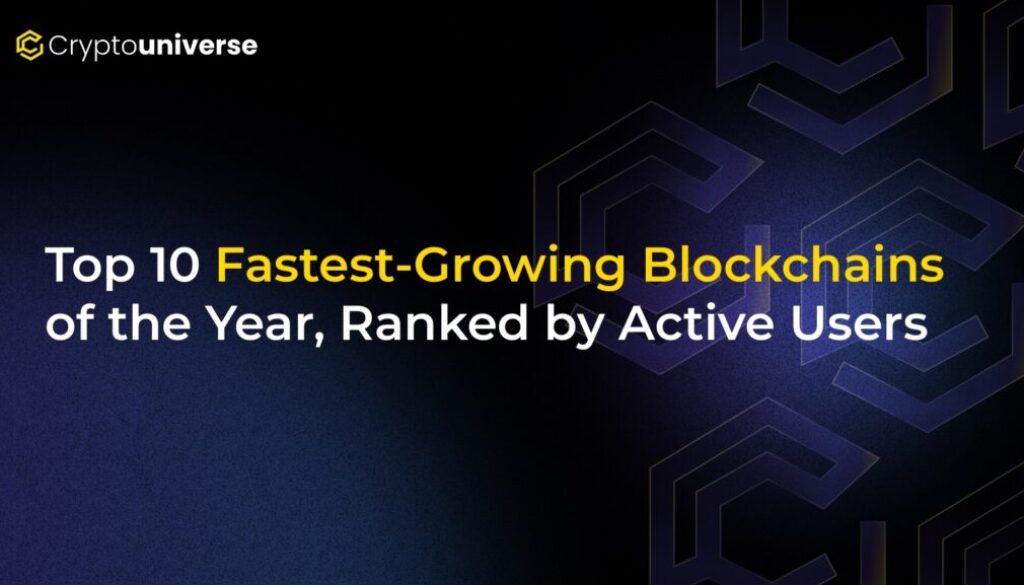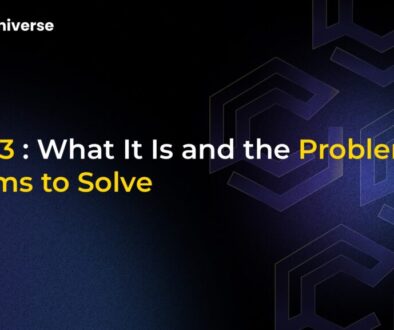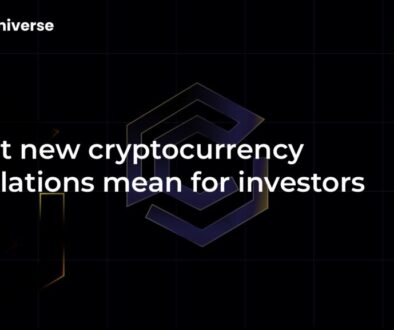Top 10 Fastest-Growing Blockchains of the Year, Ranked by Active Users

Beyond the Hype: Which Blockchains Are Actually Winning Users?
The crypto landscape is maturing. The days of speculation and hype driving the market are giving way to a new era defined by real-world utility and genuine user adoption. In this competitive environment, the ultimate measure of a blockchain’s success isn’t just its token price—it’s the number of people actively using it. So, which networks are leading the charge in 2024 and 2025?
From high-speed Layer-1s powering decentralized finance (DeFi) to innovative Layer-2s making Ethereum more accessible than ever, the race is on. This article dives deep into the data to rank the top 10
First, Some Key Concepts
Before we jump into the rankings, let’s clarify a few terms:
- Active Users: This refers to a unique wallet address that has completed at least one transaction on the network within a specific period (in our case, monthly). It’s a powerful indicator of real engagement.
- Layer 1 (L1) vs. Layer 2 (L2): L1s are the foundational blockchains, like Bitcoin or Ethereum, that process and validate transactions on their own network. L2s are scaling solutions built on top of L1s (like Arbitrum on Ethereum) to make transactions faster and cheaper.
The Top 10 Fastest-Growing Blockchains by Monthly Active Users
1. Solana (SOL)
A high-performance Layer-1 known for its incredible speed and low transaction costs.
- Monthly Active Users: 57 million
- 30-Day Trading Volume: $284.2 billion
- Key Growth Drivers: Solana’s explosive growth is fueled by a thriving DeFi ecosystem, a frenzy of memecoin trading that leverages its high throughput, and the launch of the Firedancer validator client, which has significantly improved network reliability. Growing institutional interest continues to pour in.
- Challenges: Despite improvements, Solana’s reputation is still colored by past network outages. It also faces criticism over its degree of centralization and fierce competition from Ethereum’s L2 ecosystem.
2. Near Protocol (NEAR)
A developer-friendly Layer-1 focused on usability, scalability, and AI integration.
- Monthly Active Users: 51.2 million
- 30-Day Trading Volume: $7.8 million
- Key Growth Drivers: Near is carving out a unique niche with its focus on AI, aiming to support user-owned agents and decentralized AI applications. Its carbon-neutral status, low fees, and strategic partnerships, including one with EigenLayer for faster finality, have attracted a surge of developers and users, particularly in DeFi and gaming.
- Challenges: Near competes in a crowded market of fast L1s and scalable L2s. While user growth is strong, it needs to translate into higher on-chain value and withstand token price volatility.
3. BNB Chain (BNB)
A high-performance Layer-1 backed by Binance, offering EVM compatibility and a massive DApp ecosystem.
- Monthly Active Users: 46.4 million
- 30-Day Trading Volume: $56.1 billion
- Key Growth Drivers: With over 5,800 DApps, BNB Chain leads the pack in ecosystem size. Recent upgrades reducing block times and integrating AI-powered data ownership tools have further boosted its appeal. Its connection to the world’s largest crypto exchange provides a steady stream of new users.
- Challenges: Its close ties to Binance raise persistent concerns about centralization. The network also operates under the shadow of intense regulatory scrutiny directed at Binance globally.
4. Base
An Ethereum Layer-2 developed by Coinbase, designed for mass adoption through low costs and easy onboarding.
- Monthly Active Users: 21.5 million
- Key Growth Drivers: Base’s superpower is its direct integration with Coinbase, giving it access to a potential user base of over 100 million people. With transaction fees averaging just $0.01, it has become a hotspot for consumer-facing DApps, social finance (SocialFi), and stablecoin activity.
- Challenges: Its rapid popularity has led to periods of network congestion. As an L2, its security is dependent on Ethereum, and its connection to a major U.S. exchange places it squarely in the sights of regulators.
5. Tron (TRX)
A high-throughput Layer-1 optimized for decentralized content sharing and stablecoin transactions.
- Monthly Active Users: 14.4 million
- 30-Day Trading Volume: $51.7 billion
- Key Growth Drivers: Tron’s primary use case is low-cost, high-speed stablecoin (especially USDT) transfers, making it a dominant player in global payments. Recent integrations with Telegram and AI initiatives are expanding its utility.
- Challenges: Like BNB Chain, Tron faces questions about its level of decentralization and has been the subject of regulatory actions in the past.
6. Bitcoin (BTC)
The original blockchain, now evolving beyond digital gold with new layers of functionality.
- Monthly Active Users: 10.8 million
- 30-Day Trading Volume: $1.3 trillion
- Key Growth Drivers: The approval of spot Bitcoin ETFs has unlocked a firehose of institutional capital, with professional investors pouring billions into the asset. The recent halving event, which reduced new supply, and its growing adoption as a strategic reserve asset by corporations and even nations continue to drive its relevance.
- Challenges: Its proof-of-work consensus mechanism consumes significant energy, and its price remains volatile in response to macroeconomic shifts. Scalability on the base layer is also limited.
7. Aptos (APT)
A Layer-1 built by former Meta engineers using the secure Move programming language.
- Monthly Active Users: 10 million
- 30-Day Trading Volume: $13 billion
- Key Growth Drivers: Aptos is built for security and scalability, boasting impressive peak transaction speeds. The Move language, designed for safer smart contracts, is a major draw for developers. Key partnerships, including the native launch of Tether (USDT), are helping build momentum.
- Challenges: As a newer L1, Aptos is still working to build a DApp ecosystem as rich as its competitors and needs to achieve broader user adoption to rival established players.
8. Ethereum (ETH)
The leading smart contract platform and the foundation of DeFi, NFTs, and the L2 ecosystem.
- Monthly Active Users: 9.6 million
- 30-Day Trading Volume: $1.1 trillion
- Key Growth Drivers: Despite high fees, Ethereum remains the king of developer activity and on-chain value. The upcoming Pectra upgrade promises to improve user experience and scalability. The potential approval of spot Ether ETFs and the growth of institutional staking are also major catalysts.
- Challenges: High gas fees and slower transaction speeds remain significant hurdles, pushing users toward cheaper L1s and L2s. Ongoing regulatory pressure also creates uncertainty.
9. Polygon (MATIC)
A leading multi-chain scaling solution for Ethereum, often called the “internet of blockchains.”
- Monthly Active Users: 7.2 million
- 30-Day Trading Volume: $4.2 billion
- Key Growth Drivers: Polygon has successfully attracted major enterprises like Starbucks and Adobe. Its suite of scaling solutions and focus on interoperability, enhanced by upgrades like Heimdall v2, make it a versatile hub for DeFi, NFTs, and enterprise applications.
- Challenges: It faces intense competition from other L2s like Arbitrum and Base. New European regulations like MiCA could also introduce compliance hurdles for its ecosystem.
10. Arbitrum One (ARB)
The leading Ethereum Layer-2 by total value locked, known for its robust DeFi ecosystem.
- Monthly Active Users: 4 million
- 30-Day Trading Volume: $14.3 billion
- Key Growth Drivers: Arbitrum dominates the L2 space in terms of capital, hosting a vibrant ecosystem of cutting-edge DeFi protocols. Integrations with platforms like Robinhood and technical upgrades like Stylus, which lowers fees even further, are solidifying its position. Recent data also shows consistently high development activity on the network.
- Challenges: Its success is tied to Ethereum’s mainnet, and it faces stiff competition from other L2s. The evolving regulatory landscape for Layer-2 solutions remains a key uncertainty.
Beyond Active Users: Other Ways to Measure Growth
While active users are a fantastic metric for adoption, a full picture requires looking at other indicators. Social media and on-chain data show other chains making serious moves:
- Total Value Locked (TVL): This measures the total amount of assets staked or locked in a blockchain’s DeFi protocols. For instance, Sui Network has recently surged into the top 10 chains by TVL, challenging L2 giants like Base and Arbitrum with its rapid capital inflows.
- Development Activity: This tracks the amount of work being done on a blockchain’s core technology and DApps. Chains like MultiversX, Zetachain, and BNB Chain have shown explosive growth in development activity, signaling a strong foundation for future innovation.
- DApp Ecosystem: The sheer number of applications on a network indicates a healthy and attractive environment for builders. BNB Chain (5,870+ DApps), Ethereum (5,120+ DApps), and Polygon (2,480+ DApps) lead the industry in this regard.
Conclusion: A Multi-Chain Future Driven by Utility
The rankings highlight a clear trend: the future of blockchain is diverse and driven by tangible value. High-speed, low-cost networks like Solana are capturing retail and DeFi users, while Ethereum’s Layer-2 solutions like Arbitrum and Base are making decentralized applications accessible to the masses. Meanwhile, giants like Bitcoin and Ethereum are evolving with institutional capital and major technical upgrades.
However, challenges like scalability trade-offs, regulatory uncertainty, and the risk of inflated metrics remain. The blockchains that will continue to grow are those that can solve these problems while delivering real utility—whether through finance, gaming, AI, or content creation. As the industry matures, tracking active users will remain the truest measure of which platforms are not just surviving, but thriving.


